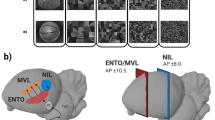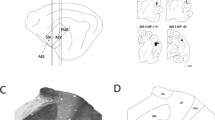Abstract
Optic tectum and pretectum are two main structures for parallel processing of contralateral retinal inputs. Since it is known from anatomic studies that pretectum projects to ipsilateral tectum, the present investigation focuses on the physiological properties of this information transfer. (1) Extracellular single cell recordings from pretectal thalamic nuclei in cane toads Bufo marinus revealed different classes of neurons, TH1 to TH10, comparable to the ones described previously in B. americanus, except TH9. A further class TH11 responded specifically to the temporonasal direction of movement of a large object or textured surface. (2) Most neurons belonged to the classes TH3 and TH4, sensitive particularly to large moving objects and responsive to moving textured surfaces independent of the horizontal direction of movement. Nearly one third could be antidromically activated to electrical stimulation of the ipsilateral optic tectum, by the criterion of the collision test, that is ultimate proof of their pretectotectal projective character. (3) Among the remaining neurons, one tonically discharging TH1 cell fulfilled the collision test. (4) It is suggested that TH3 cells inform topographically corresponding structures of the tectal visual map about large moving objects and their extension perpendicular to the direction of movement, hence contributing to the discrimination between prey and non-prey. Class TH4 pretectotectal projection cells with inputs from the entire monocular or binocular visual field inform the tectum about large objects moving anywhere in the visual field and about a moving textured surrounding that fills the visual field. The latter would allow the tectum to discriminate object motion from self-induced motion.
Similar content being viewed by others
Abbreviations
- A :
-
stripe in antiworm configuration, oriented perpendicular to the direction of movement
- W :
-
stripe in worm configuration, oriented parallel to the direction of movement
- S :
-
square
- C E C T :
-
empirical and theoretical collision interval, respectively
- ERF :
-
excitatory receptive field
- IRF :
-
inhibitory receptive field
- L, R :
-
neuronal response latency and absolute refractory period, respectively
- Lpd Lpv P:
-
lateral posterodorsal, lateral posteroventral, and posterior pretectal thalamic nucleus, respectively
- NT TN :
-
nasotemporal or temporonasal direction of stimulus movement in the visual field of the eye
- OT :
-
optic tectum
- TH :
-
classes of pretectal thalamic neurons
References
Arbib MA (1989) Visuomotor coordination: neural models and perceptual robotics. In: Ewert J-P, Arbib MA (eds) Visuomotor coordination, amphibians, comparisons, models, and robots. Plenum Press, New York, pp 121–171
Bieger D, Neuman RS (1984) Selective accumulation of hydroxytryptamines by frogs tectal neurons. Neuroscience 12: 1167–1177
Birukow G (1938) Untersuchungen über den optischen Drehnystagmus und über die Sehschärfe des Grasfrosches (Rana temporaria L). Z Vergl Physiol 25: 92–142
Brown WT, Ingle D (1973) Receptive field changes produced in frog thalamic units by lesions of the optic tectum. Brain Res 59: 405–409
Brown WT, Marker WB (1977) Unit responses in the frog's caudal thalamus. Brain Behav Evol 14: 274–297
Burghagen H, Ewert J-P (1983) Influence of the background for discriminating object motion from self-induced motion in toads Bufo bufo (L). J Comp Physiol 152: 241–249
Cochran SL, Dieringer N, Precht W (1984) Basic optokinetic-ocular reflex patterns in the frog. J Neurosci 4: 43–57
Ewert J-P (1968) Der Einfluß von Zwischenhirndefekten auf die Visuomotorik im Beute- und Fluchtverhalten der Erdkröte (Bufo bufo L). Z Vergl Physiol 61: 41–70
Ewert J-P (1971) Single unit response of the toad (Bufo americanus) caudal thalamus to visual objects. Z Vergl Physiol 74: 81–102
Ewert J-P (1984) Tectal mechanisms that underlie prey-catching and avoidance behaviors in toads. In: Vanegas H (ed) Comparative neurology of the optic tectum. Plenum Press, New York London, pp 247–416
Ewert J-P (1987) Neuroethology of releasing mechanisms: preycatching in toads. Behav Brain Sci 10: 337–405
Ewert J-P (1992) Neuroethology of an object features relating algorithm and its modification by learning. Rev Neurosci 3: 45–63
Ewert J-P, Wietersheim Av (1974a) Musterauswertung durch tectale und thalamus/praetectale Nervennetze im visuellen System der Kröte (Bufo bufo L). J Comp Physiol 92: 131–148
Ewert J-P, Wietersheim Av (1974b) Der Einfluß von Thalamus/Praetectum-Defekten auf die Antwort von Tectum-Neuronen gegenüber bewegten visuellen Mustern bei der Kröte (Bufo bufo L). J Comp Physiol 92: 149–160
Ewert J-P, Hock FJ, Wietersheim Av (1974) Thalamus/Praetectum/Tectum: retinale Topographie und physiologische Interaktionen bei der Kröte (Bufo bufo L). J Comp Physiol 92: 343–356
Ewert J-P, Burghagen H, Schürg-Pfeiffer E (1983) Neuroethological analysis of the innate releasing mechanism for prey-catching behavior in toads. In: Ewert J-P, Capranica RR, Ingle DJ (eds) Advances in vertebrate neuroethology. Plenum Press, New York London, pp 413–475
Ewert J-P, Framing EM, Schürg-Pfeiffer E, Weerasuriya A (1990) Responses of medullary neurons to moving visual stimuli in the common toad: I. Characterization of medial reticular neurons by extracellular recording. J Comp Physiol A 167: 495–508
Ewert J-P, Beneke TW, Schürg-Pfeiffer E, Schwippert WW, Weerasuriya A (1994) Sensorimotor processes that underlie feeding behavior in tetrapods. In: Bels VL, Chardon M, Vandevalle P (eds) Advances in comparative and environmental physiology, Vol. 18: Biomechanics of feeding in vertebrates. Springer, Berlin Heidelberg New York, pp 119–161
Fite KV, Scalia F (1976) Central visual pathways in the frog. In: Fite KV (ed) The amphibian visual system: a multidisciplinary approach. Academic Press, New York San Francisco London, pp 87–118
Frost BJ (1982) Mechanisms for discriminating object motion from self-induced motion in the pigeon. In: Ingle DJ, Goodale MA, Mansfield RJW (eds) Analysis of visual behavior. The MIT Press, Cambridge, pp 177–196
Fuller JH, Schlag JD (1976) Determination of antidromic excitation by the collision test: problems of interpretation. Brain Res 112: 283–298
Gaillard F, Galand G (1979) Diencephalic binocular wide field neurons in the frog. Exp Brain Res 34: 511–520
Grüsser O-J, Grüsser-Cornehls U (1973) Neuronal mechanisms of visual movement perception and some psychological and behavioral correlates. In: Jung R (ed) Central processing of visual information: integrative functions and comparative data. (Handbook of Sensory Physiology, Vol. VII/3A). Springer, Berlin Heidelberg New York, pp 333–429
Heiden an der U, Roth G (1989) Retina and optic tectum in amphibians: a mathematical model and simulation studies. In: Ewert J-P, Arbib MA (eds) Visuomotor coordination: amphibians, comparisons, models, and robots. Plenum Press, New York London, pp 243–267
Holst E v, Mittelstaedt H (1950) Das Reafferenzprinzip. Naturwissenschaften 37: 464–476
Ingle D (1973) Disinhibition of tectal neurons by pretectal lesions in the frog. Science 180: 422–424
Ingle D (1976) Behavioral correlates of central visual function in anurans. In: Llinás R, Precht W (eds) Frog neurobiology. Springer, Berlin Heidelberg New York, pp 435–451
Ingle D (1977) Detection of stationary objects by frogs (Rana pipiens) after ablation of optic tectum. J Comp Physiol Psychol 91: 1359–1364
Ingle D (1980) Some effects of pretectum lesions on the frog's detection of stationary objects. Behav Brain Res 1: 139–163
Ingle D (1983a) Prey selection in frogs and toads: a neuroethological model. In: Satinoff E, Teitelbaum P (eds) Handbook of behavioral neurobiology, Vol. 6: Motivation. Plenum Press, New York, pp 235–261
Ingle DJ (1983b) Brain mechanisms of visual localization by frogs and toads. In: Ewert J-P, Capranica RR, Ingle DJ (eds) Advances in vertebrate neuroethology. Plenum Press, New York London, pp 177–226
Katte O, Hoffmann K-P (1980) Direction specific neurons in the pretectum of the frog (Rana esculenta). J Comp Physiol 140: 53–57
Kozicz T, Lázár G (1994) The origin of tectal NPY immunopositive fibers in the frog. Brain Res 635: 345–348
Lázár G (1971) The projection of the retinal quadrants on the optic centers in the frog. Acta Morphol Acad Sci Hung 19: 325–334
Lázár G (1972) Role of accessory optic system in the optokinetic nystagmus of the frog. Brain Behav Evol 5: 443–460
Lázár G (1989) Cellular architecture and connectivity of the frog's optic tectum and pretectum. In: Ewert J-P, Arbib MA (eds) Visuomotor coordination: amphibians, comparisons, models, and robots. Plenum Press, New York London, pp 175–199
Lázár G, Alkony B, Tóth P (1983) Reinvestigation of the role of the accessory optic system and the pretectum in the horizontal head nystagmus of the frog. Lesion experiments. Acta Biol Acad Sci Hung 34: 385–393
Lettvin JY, Maturana HR, McCulloch WS, Pitts WH (1959) What the frog's eye tells the frog's brain. Proc Inst Radio Engin 47: 1940–1951
Lipski J (1981) Antidromic activation of neurons as an analytic tool in the study of the central nervous system. J Neurosci Methods 4: 1–32
Manteuffel G (1984) Electrophysiology and anatomy of direction-specific pretectal units in Salamandra salamandra. Exp Brain Res 54: 415–425
Manteuffel G (1985) Monocular and binocular optic inputs to salamander pretectal neurons: intracellular recording and HRP labelling study. Brain Behav Evol 27: 1–10
Manteuffel G (1987) Binocular afferents to salamander pretectum mediate rotation sensitivity of cells selective for visual background motions. Brain Res 422: 381–383
Manteuffel G (1989) Compensation of visual background motion in salamanders. In: Ewert J-P, Arbib MA (eds) Visuomotor coordination: amphibians, comparisons, models, and robots. Plenum Press, New York London, pp 311–340
Matsumoto N (1989) Morphological and physiological studies of tectal and pretectal neurons in the frog. In: Ewert J-P, Arbib MA (eds) Visuomotor coordination: amphibians, comparisons, models, and robots. Plenum Press, New York London, pp 201–222
Merchenthaler I, Lázár G, Maderdrut, JL (1989) Distribution of proenkephalin-derived peptides in the brain of Rana esculenta. J Comp Neurol 281: 23–39
Montgomery N, Fite KV, Taylor M, Bengston L (1982) Neural correlates of optokinetic nystagmus in the mesencephalon of Rana pipiens: functional analysis. Brain Behav Evol 21:137–150
Montgomery NM, Fite KV, Grigonis AM (1985) The pretectal nucleus lentiformis mesencephali of Rana pipiens. J Comp Neurol 234: 264–275
Neary T, Northcutt RG (1983) Nuclear organization of the bullfrog diencephalon. J Comp Neurol 213: 262–278
Rehn B (1977) Cerebrale Repräsentation des Fluchtverhaltens der Erdkröte (Bufo bufo L). PhD Thesis, Technical Univ Darmstadt
Satou M, Matsushima T, Takeuchi H, Ueda K (1985) Tongue-muscle-controlling motoneurons in the Japanese toad: topography, morphology and neuronal pathways from the ‘snapping-evoking area’ in the optic tectum. J Comp Physiol A 157: 717–737
Schürg-Pfeiffer E, Spreckelsen C, Ewert J-P (1994) Temporal discharge patterns of tectal and medullary neurons chronically recorded during snapping toward prey in toads Bufo bufo spinosus. J Comp Physiol A 173: 363–376
Schwippert WW, Beneke TW, Ewert J-P (1995) Pretecto-tectal influences II. How retinal and pretectal inputs to the toad's superficial tectum interact: a study of electrically evoked field potentials. J Comp Physiol A 176: 181–192
Sparks DL (1988) Neural cartography: sensory and motor maps in the superior colliculus. In: Finger TE (ed) Neural cartography: how does the CNS use sensory maps? Karger, Basel, pp 49–55
Székely G, Lázár G (1976) Cellular and synaptic architecture of the optic tectum. In: Llinás R, Precht W (eds) Frog neurobiology. Springer, Berlin Heidelberg New York, pp 407–434
Tóth P, Csank G, Lázár G (1985) Morphology of the cells of origin of descending pathways to the spinal cord in Rana esculenta. A tracing study using cobalt-lysine complex. J Hirnforsch 26: 365–383
sai H-J (1990) Responses of toad's tectal neurons to in-phase and anti-phase movements of object and textured background. J Comp Physiol A 167: 857–863
Tsai H-J, Ewert J-P (1988) Influence of stationary and moving textured backgrounds on the response of visual neurons in toads (Bufo bufo L). Brain Behav Evol 32: 27–38
Weerasuriya A, Ewert J-P (1981) Prey-selective neurons in the toad's optic tectum and sensorimotor interfacing: HRP studies and recording experiments. J Comp Physiol 144: 429–434
Weerasuriya A, Ewert J-P (1983) Afferents of some dorsal retino-recipient areas of the brain of Bufo bufo. Soc Neurosci Abstr 9: 536
Wietersheim A v, Ewert J-P (1978) Neurons of the toad's (Bufo bufo L) visual system sensitive to moving configurational stimuli: a statistical analysis. J Comp Physiol 126: 35–42
Wilczynski W, Northcutt RG (1977) Afferents to the optic tectum of the leopard frog: an HRP study. J Comp Neurol 173: 219–229
Author information
Authors and Affiliations
Rights and permissions
About this article
Cite this article
Buxbaum-Conradi, H., Ewert, J.P. Pretecto-tectal influences. J Comp Physiol A 176, 169–180 (1995). https://doi.org/10.1007/BF00239920
Accepted:
Issue Date:
DOI: https://doi.org/10.1007/BF00239920




